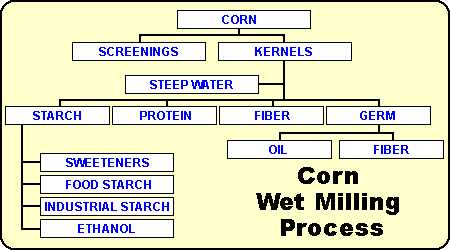 .
.Ethanol: a clear, colorless liquid with a characteristic, agreeable odor. It is produced by fermenting biomass, commonly corn.
Other Names: Ethyl Alcohol, Grain Alcohol
Formula: C2H5OH
There are basically eight steps in the ethanol production process:
1. Milling: The corn (or barley or wheat) will first pass through hammer mills, which grind it into a fine powder called meal.
2. Liquefaction: The meal will then be mixed with water and alpha-amylase, and will pass through cookers where the starch is liquefied. Heat will be applied at this stage to enable liquefaction. Cookers with a high temperature stage (120-150 degrees Celsius) and a lower Temperature-holding period (95 degrees Celsius) will be used. These high temperatures reduce bacteria levels in the mash.
3. Saccharification: The mash from the cookers will then be cooled and the secondary enzyme (gluco-amylase) will be added to convert the liquefied starch to fermentable sugars (dextrose), a process called saccharification.
4. Fermentation: Yeast will then be added to the mash to ferment the sugars to ethanol and carbon dioxide. Using a continuous process, the fermenting mash will be allowed to flow, or cascade, through several fermenters until the mash is fully fermented and then leaves the final tank. In a batch fermentation process, the mash stays in one fermenter for about 48 hours before the distillation process is started.
5. Distillation: The fermented mash, now called "beer," will contain about 10% alcohol, as well as all the non-fermentable solids from the corn and the yeast cells. The mash will then be pumped to the continuous flow, multi-column distillation system where the alcohol will be removed from the solids and the water. The alcohol will leave the top of the final column at about 96% strength, and the residue mash, called stillage, will be transferred from the base of the column to the co-product processing area.
6. Dehydration: The alcohol from the top of the column will then pass through a dehydration system where the remaining water will be removed. Most ethanol plants use a molecular sieve to capture the last bit of water in the ethanol. The alcohol product at this stage is called anhydrous (pure, without water) ethanol and is approximately 200 proof.
7. Denaturing: Ethanol that will be used for fuel is then denatured with a small amount (2-5%) of some product, like gasoline, to make it unfit for human consumption.
8. Co-Products: There are two main co-products created in the production of ethanol: carbon dioxide and distillers grain. Carbon dioxide is given off in great quantities during fermentation and many ethanol plants collect that carbon dioxide, clean it of any residual alcohol, compress it and sell it for use to carbonate beverages or in the flash freezing of meat. Distillers grains, wet and dried, are high in protein and other nutrients and are a highly valued livestock feed ingredient. Some ethanol plants also create a "syrup" containing some of the solids that can be a separate production sold in addition to the distiller's grain, or combined with it. Ethanol production is a no-waste process that adds value to the corn by converting it into more valuable products.


